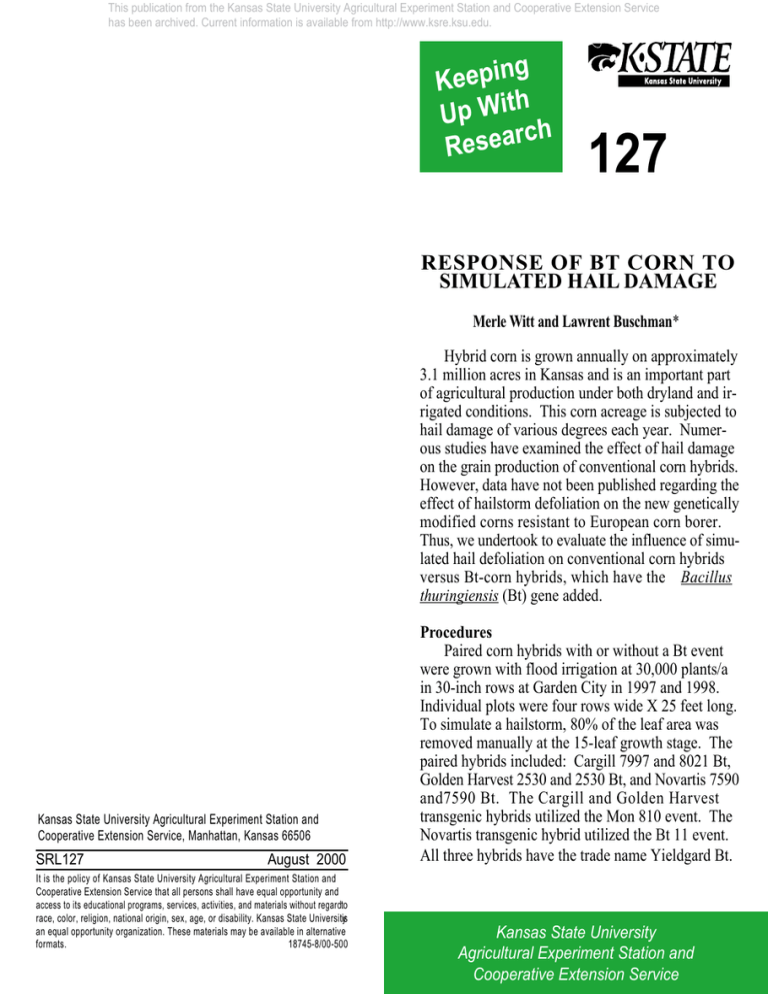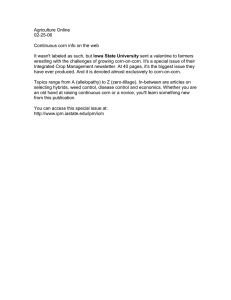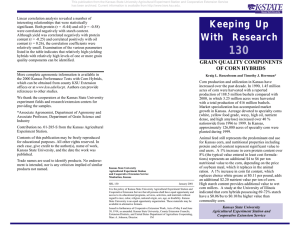
This publication from the Kansas State University Agricultural Experiment Station and Cooperative Extension Service
has been archived. Current information is available from http://www.ksre.ksu.edu.
g
Keepin
h
Up Wit
ch
Resear
127
RESPONSE OF BT CORN TO
SIMULATED HAIL DAMAGE
Merle Witt and Lawrent Buschman*
Hybrid corn is grown annually on approximately
3.1 million acres in Kansas and is an important part
of agricultural production under both dryland and irrigated conditions. This corn acreage is subjected to
hail damage of various degrees each year. Numerous studies have examined the effect of hail damage
on the grain production of conventional corn hybrids.
However, data have not been published regarding the
effect of hailstorm defoliation on the new genetically
modified corns resistant to European corn borer.
Thus, we undertook to evaluate the influence of simulated hail defoliation on conventional corn hybrids
versus Bt-corn hybrids, which have the Bacillus
thuringiensis (Bt) gene added.
Kansas State University Agricultural Experiment Station and
Cooperative Extension Service, Manhattan, Kansas 66506
SRL127
August 2000
It is the policy of Kansas State University Agricultural Experiment Station and
Cooperative Extension Service that all persons shall have equal opportunity and
access to its educational programs, services, activities, and materials without regardto
race, color, religion, national origin, sex, age, or disability. Kansas State Universityis
an equal opportunity organization. These materials may be available in alternative
formats.
18745-8/00-500
Procedures
Paired corn hybrids with or without a Bt event
were grown with flood irrigation at 30,000 plants/a
in 30-inch rows at Garden City in 1997 and 1998.
Individual plots were four rows wide X 25 feet long.
To simulate a hailstorm, 80% of the leaf area was
removed manually at the 15-leaf growth stage. The
paired hybrids included: Cargill 7997 and 8021 Bt,
Golden Harvest 2530 and 2530 Bt, and Novartis 7590
and7590 Bt. The Cargill and Golden Harvest
transgenic hybrids utilized the Mon 810 event. The
Novartis transgenic hybrid utilized the Bt 11 event.
All three hybrids have the trade name Yieldgard Bt.
Kansas State University
Agricultural Experiment Station and
Cooperative Extension Service
This publication from the Kansas State University Agricultural Experiment Station and Cooperative Extension Service
has been archived. Current information is available from http://www.ksre.ksu.edu.
Results
The simulated hail damage caused average reductions in grain yield of 81 bu/a in 1997 and 63 bu/a
in 1998. Yield losses were not significantly different
for conventional and Bt hybrids. However, corn
borer stalk tunneling was lacking in the Bt hybrids,
whereas their conventional hybrid counterparts had
42% of stalks infested in 1997 and 55% of stalks in
1998. Because of the elimination of insect tunneling
damage, the Bt hybrids averaged 11% higher yield in
1997 and 8% higher yield in 1998. Resulting grain
yields are shown in Table 1.
Conclusions
Essentially all dry matter in the corn plant is produced by photosynthesis in the leaves. Therefore,the
potential grain yield is determined by the amount of
leaf area present to produce dry matter. A hailstorm
that reduces the leaf area will result in reduced
growth rate and grain production. Genetically modified hybrids with a Bt gene addition had no Euro
pean
corn borer damage, but the Bt gene did not have a
significant influence on grain yield loss following simulated hail defoliation. Grain yield was reduced by
37% when 80% of the leaf area was removed at the
15-leaf growth stage.
Table 1. Harvest results of conventional and Bt
corn following simulated hail damage at
the 15-leaf stage, Southwest ResearchExtension Center, Garden City, KS
Grain Yield (bu/a)
1997
1998
HybridControlDefolControlDefolLoss
%
Yield
Conventional21913416410338.5
Genetically
Modified (Bt) 23015218011536.0
LSD (5%)
n.s.111412n.s.
Defol = defoliated
Yield corrected to 15.5% moisture; n.s. = not significant.
Acknowledgement
Funding for this study was provided by the
National Crop Insurance Services.
* Associate Professor, KSU Southwest ResearchExtension Center and Professor, Department of
Entomology (located at SWREC).
Contribution no. 00-432-S from the Kansas
Agricultural Experiment Station.
Note: Trade names are used to identify products.
No endorsement is intended, nor is any criticism
implied of similar products not mentioned.
Contents of this publication may be freely reproduced for educational purposes. All other rights
reserved. In each case, give credit to the author(s),
name of work, Kansas State University, and the date
the work was published.






